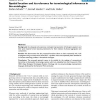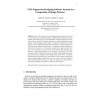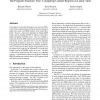446 search results - page 72 / 90 » Formal concept analysis based on hierarchical class analysis |
BMCBI
2007
15 years 17 days ago
2007
Background: An adequate and expressive ontological representation of biological organisms and their parts requires formal reasoning mechanisms for their relations of physical aggr...
96
Voted
ICHIT
2009
Springer
15 years 7 months ago
2009
Springer
Middleware facilitates the development of distributed systems by accommodating heterogeneity, hiding distribution details and providing a set of common and domain specific service...
CSL
2010
Springer
15 years 1 months ago
2010
Springer
Abstract. We present a symbolic framework, based on a modular operational semantics, for formalizing different notions of compromise relevant for the analysis of cryptographic prot...
105
click to vote
UML
2001
Springer
15 years 4 months ago
2001
Springer
Much of the research work on design patterns has primarily focused on discovering and documenting patterns. Design patterns promise early reuse benefits at the design stage. To rea...
106
click to vote
PLDI
1994
ACM
15 years 4 months ago
1994
ACM
In this paper, we describe the program structure tree (PST), a hierarchical representation of program structure based on single entry single exit (SESE) regions of the control flo...



